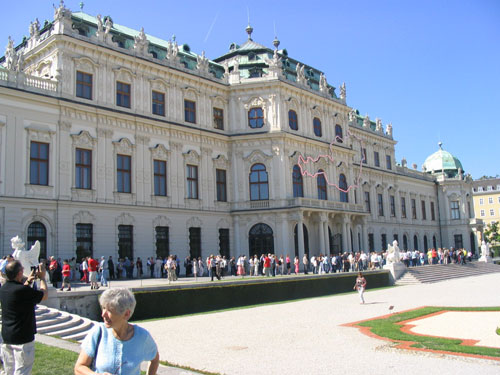Although the term Gesamtkunstwerk originates from Richard Wagner and serves to designate the attempt to fuse the arts of theater, music and artistic creation in a single piece, this concept was also central to the artists of the Viennese Secession environment, as they found it fit to express their aesthetic aspirations.

Such aspirations materialize in a unique and representative way by the close and intense collaboration between two of the most outstanding members of the Secession and its sequels, the painter Gustav Klimt (1862-1918) and architect and designer Josef Hoffmann (1870-1956) , who worked together on important projects such as the Beethoven Exhibition of the Vienna Secession (1902) and the Palais Stoclet in Brussels (1905-1912), whose design was ordered by the belgian millionaire Adolphe Stoclet to be built by Hoffmann without any economic restrictions Stoclet, who had lived some time in the Austrian capital was seduced by the secessionist aesthetic ideas that first allowed Hoffmann to produce his particular ideal of a modern Gesamtkunstwerk, each of whose elements (carpets, wallpapers, glass, silver, tableware, lighting , furniture, accessories …) was designed by himself and his colleagues in Vienna, the city where he carried out the production of all of the objects.
A fruitful collaboration by Klimt and Hoffmann, within a program called Pioneers of Modernism, is exposed at the Belvedere Museum in Vienna until March 4th Klimt Gustav – josef-hoffmann-e555 ” target=”_blank”>http://www.belvedere.at/en/ausstellungen/ausstellungsvorschau/ Klimt Gustav – josef-hoffmann-e555 is called to be one of the great Central European cultural events of the next six months.
Naturally, the place could hardly be more appropriate. Not surprisingly, this impressive baroque building, part of which was an imperial gallery of paintings at the time of Mozart, has, among other priceless treasures, the largest collection of Klimt paintings in the world, including his famous painting The Kiss .
The exhibition serves to highlight the importance of the cooperation between these dazzling artists who made moved to Vienna being during their time such an utterly fascinating place, a fascination where perspective is no stranger to the knowledge that the great Austrian Central European culture was living a real cultural and social explosion before its complete dissolution after the First World War admirably documented by literature of the time in books such as the masterpiece The Man Without Qualities .
On the other hand, the moment illuminates not only the close cooperation and common interests between the two artists, but the mutual influence of one and each other, evidenced for example in the famous portrait of Klimt Fritza Riedler, where we see the hand of Hoffmann or the involvement of both in the Wiener Werkstätte or Viennese Workshops, where the evolution of the Viennese Secession aspired to the conversion of all facets of human life in a unified work of art whose most representative piece is probably the aforementioned Stoclet Palace.
If you rent apartments in Vienna during the dates of this exhibition, do not miss it. The importance of the two protagonists and the cultural moment in which both made ??their magnificent work makes the event a special opportunity to deepen into the knowledge of an exciting period.
 Translated by: Marc
Translated by: Marc
Contact Me

 English
English


